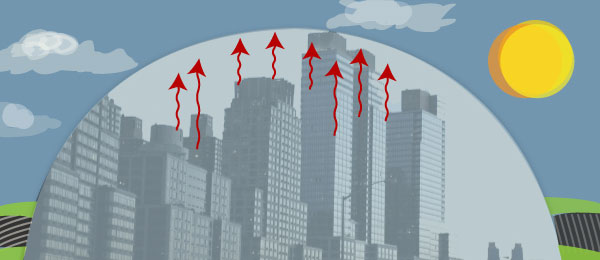research
EXPERTS
Christopher Kucharik
Professor
Agronomy, Nelson Institute Center for Sustainability and the Global Environment
Jason Schatz
Postdoctoral Researcher
Related Video
urban heat island

Virtually every city experiences an urban heat island effect, or the phenomenon in which cities are warmer than their rural surroundings. A city's high building density and paved surfaces cause it to retain more heat than open, natural areas. Cities can be 3 to 7 degrees warmer at night and 1 to 3 degrees warmer during the day, with clear and calm weather conditions making temperatures even higher.
The heat island effect can have significant impacts on human health, energy demands for heating and cooling, local ecosystems, and the water cycle, making understanding how it works important to mitigating these risks.
With Wisconsin's greater Madison area as its study site, our urban climate research team investigated how plant cover and building density can affect the local climate, and how the local climate subsequently influences quality of life for people. This research relied on a network of 150 temperature and humidity sensors installed on streetlights and utility poles across the metropolitan area, which have been taking recordings every 15 minutes since 2012.*
The team's findings can inform city planning and other efforts to build resilience in urban areas, especially as the global climate warms.
What we asked
- How and why do temperature and humidity vary across the Madison region?
- What effects does the urban climate have on human health, quality of life, local ecosystems, and the water cycle?
What we found
- More densely built parts of Madison have the highest temperatures and lowest humidity in the region due to the heat island effect. This effect is stronger during the summer, particularly during heat waves, when additional heat poses the greatest health risks and higher electricity demand from air conditioning.
- Madison's lakes affect the local climate only very close to the lakeshore, where temperatures tend to be lower during the day and higher at night. The lakes also raise humidity at near-shore locations.
- In more developed urban areas where vegetation is scarce, the local heat island effect intensifies, creating warmer and drier conditions that put additional water stress on any plants that do grow in these areas. In fact, plants in Madison's dense urban parts require up to 10% more water over the growing season compared to plants in more rural areas.
- The growing season in Madison lasts around five days longer than in surrounding rural areas, meaning the meteorological conditions that contribute to trees leafing out and gardens growing last a little longer in the city. Moreover, the heat island effect can protect a city against late spring and early fall freezes, and often keeps urban nighttime temperatures above freezing on nights when rural areas experience mild freezes.
*WSC partnered with local governments and utilities to make this research possible: Madison Gas & Electric, Alliant Energy, the City of Madison, Madison Parks, Sun Prairie Utilities, Waunakee Utilities, the UW-Madison Arboretum, the City of Fitchburg, and Dane County.

RESEARCH HIGHLIGHTS
Here's more reason to green our cities
Spring comes sooner to urban heat islands, with potential consequences for wildlife
Heat waves hit heat islands hardest
Making sense of urban heat island: It's about the plants





